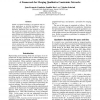Free Online Productivity Tools
i2Speak
i2Symbol
i2OCR
iTex2Img
iWeb2Print
iWeb2Shot
i2Type
iPdf2Split
iPdf2Merge
i2Bopomofo
i2Arabic
i2Style
i2Image
i2PDF
iLatex2Rtf
Sci2ools
FLAIRS
2008
2008
A Framework for Merging Qualitative Constraints Networks
Spatial or temporal reasoning is an important task for many applications in Artificial Intelligence, such as space scheduling, navigation of robots, etc. Several qualitative approaches have been proposed to represent spatial and temporal entities and their relations. These approaches consider the qualitative aspects of the space relations only, disregarding any quantitative measurement. In some applications, e. g. multi-agent systems, spatial or temporal information concerning a set of objects may be conflicting. This paper highlights the problem of merging spatial or temporal qualitative constraints networks. We propose a merging operator which, starting from a set of possibly conflicting qualitative constraints networks, returns a consistent set of spatial or temporal information representing the result of merging.
Artificial Intelligence | FLAIRS 2008 | Qualitative Constraints Networks | Spatial | Temporal Information |
| Added | 02 Oct 2010 |
| Updated | 02 Oct 2010 |
| Type | Conference |
| Year | 2008 |
| Where | FLAIRS |
| Authors | Jean-François Condotta, Souhila Kaci, Nicolas Schwind |
Comments (0)

